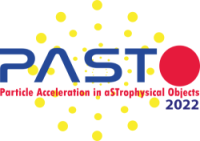Speaker
Description
Hadronic γ-ray sources associated with supernova remnants (SNRs) can serve as stopwatches for the escape of cosmic rays (CRs) from SNRs, which gradually develops from highest-energy particles to lowest-energy particles with time. In this work, we analyze the 13.7 yr Fermi-LAT data to investigate the γ-ray feature in/around the SNR G298.6−0.0 region. With ≥16 GeV data, we detect two spatial components: Src-NW at the west of the SNR, and Src-S at the south of the SNR. Then, with ≥8 GeV data, we detect an additional component — Src-NE, which is inside the radio dimension of the SNR. They are all point-like sources. Their GeV spectra are in distinct shapes, suggesting different CR populations and/or different interstellar medium distributions around them. Noteworthily, the component Src-NE inside the SNR dimension demonstrates a spectral break at ≈1.8 GeV, suggesting an old SNR age of >10 kyr. Among the three components, Src-S has the hardest spectrum extending to 30−100 GeV. Considering its separation from the SNR, its hard spectral shape is explainable in terms of the progress of the CR escape. We also look into the X-ray emission from the SNR region, with the Chandra-ACIS data. We detected several point-like keV sources and extended keV emission inside the SNR. We willl discuss the origins of their X-rays as well as the spatial morphology of the diffuse component.

